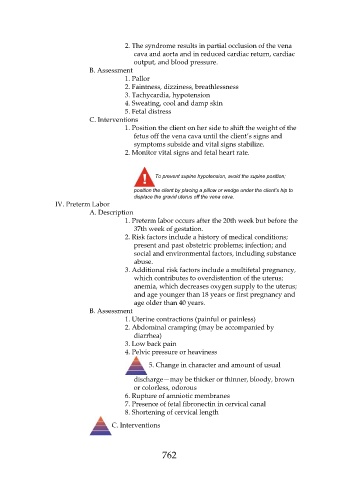Page 762 - Saunders Comprehensive Review For NCLEX-RN
P. 762
2. The syndrome results in partial occlusion of the vena
cava and aorta and in reduced cardiac return, cardiac
output, and blood pressure.
B. Assessment
1. Pallor
2. Faintness, dizziness, breathlessness
3. Tachycardia, hypotension
4. Sweating, cool and damp skin
5. Fetal distress
C. Interventions
1. Position the client on her side to shift the weight of the
fetus off the vena cava until the client’s signs and
symptoms subside and vital signs stabilize.
2. Monitor vital signs and fetal heart rate.
To prevent supine hypotension, avoid the supine position;
position the client by placing a pillow or wedge under the client’s hip to
displace the gravid uterus off the vena cava.
IV. Preterm Labor
A. Description
1. Preterm labor occurs after the 20th week but before the
37th week of gestation.
2. Risk factors include a history of medical conditions;
present and past obstetric problems; infection; and
social and environmental factors, including substance
abuse.
3. Additional risk factors include a multifetal pregnancy,
which contributes to overdistention of the uterus;
anemia, which decreases oxygen supply to the uterus;
and age younger than 18 years or first pregnancy and
age older than 40 years.
B. Assessment
1. Uterine contractions (painful or painless)
2. Abdominal cramping (may be accompanied by
diarrhea)
3. Low back pain
4. Pelvic pressure or heaviness
5. Change in character and amount of usual
discharge—may be thicker or thinner, bloody, brown
or colorless, odorous
6. Rupture of amniotic membranes
7. Presence of fetal fibronectin in cervical canal
8. Shortening of cervical length
C. Interventions
762

